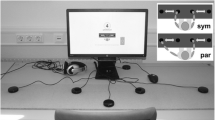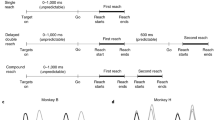Summary
The present study analyses the strategies adopted by normal subjects when they are asked to make two separate movements as rapidly as possible one after the other. Five subjects performed the following sequential movements in their own time. 1) Squeeze an isometric force transducer between fingers and thumb to a force of 30 N and then flex the elbow of the same arm through 15°. 2) Squeeze the transducer with one hand and then flex the elbow of the other arm. 3) Perform an isotonic opposition of finger and thumb and then flex the elbow of the same arm. 4) First flex the elbow through 15, 30 or 45° and then squeeze the transducer. 5) Flex and then extend the elbow as rapidly as possible. In tasks 1–4 there was no correlation between the times taken to complete the two separate components of the sequence. Because of this we suggest that the two movements remained under the control of two separate motor programmes. In contrast, in task 5, the times taken for the two components were correlated and hence we suggest that in this case a single programme was used to perform the sequence. In tasks 1–3, in which the mean duration of the first movement was some 135–162 ms, there was a mean pause of about 85 ms before the start of the second movement. Subjects tended to chose a minimum inter-onset latency between the start of the first and the start of the second movement of a sequence of some 230 ms. The reason for this appeared to be that if subjects were encouraged to decrease their interonset latencies to less than 200 ms, the speed of the second movement decreased sharply. However, if the duration of the first movement was prolonged as in task 4, the second movement could be delayed, although there now was little or no pause between the two movements. We conclude that when a single motor programme is run, it is followed by a “relative refractory period”. If a second programme is run within this period, it cannot be executed without loss of speed. Switching from one motor programme to another is achieved with an optimal minimum delay of 200 ms. Sequential movements which are controlled by a single programme do not share this limitation.
Similar content being viewed by others
References
Angel RW (1974) Electromyography during voluntary movement: the two burst pattern. Electroenceph Clin Neurophysiol 36: 493–498
Angel RW, Alston W, Higgins JR (1970) Control of movement in Parkinson's disease. Brain 93: 1–14
Benecke R, Meinck HM, Conrad B (1985) Rapid goal directed elbow flexion movements: limitations of the speed control system due to neural constraints. Exp Brain Res 59: 470–477
Benecke R, Day BL, Dick JPR, Marsden CD, Rothwell JC (1986) Performance of simultaneous movements in patients with Parkinson's disease. Brain (in press)
Berardelli A, Rothwell JC, Day BL, Kachi T, Marsden CD (1984) Duration of the first agonist EMG burst in ballistic arm movements. Brain Res 304: 183–187
Berardelli A, Rothwell JC, Dick JPR, Day BL, Marsden CD (1985) Scaling of the size of the first agonist EMG burst during rapid movements in patients with Parkinson's disease. J Neurol Neurosurg Psychiat (in press)
Brown SHC, Cooke JD (1981) Amplitude and instruction-dependent modulation of movement-related electromyogram activity in humans. J Physiol (Lond) 316: 97–107
Brown SHC, Cooke JD (1984) Initial agonist burst duration depends on movement amplitude. Exp Brain Res 55: 523–527
Carter MC, Shapiro DC (1984) Control of sequential movements: evidence for generalized motor programs. J Neurophysiol 52: 787–796
Denier van der Gon JJ, Thuring JP (1965) The guiding of human handwriting movements. Kybernetik 2: 145–148
Denier vander Gon JJ, Wadman WJ (1977) Control of fast ballistic human arm movements. J Physiol (Lond) 271: 28–29p
Dick JPR, Cowan JMA, Day BL, Berardelli A, Kachi T, Rothwell JC, Marsden CD (1984) The corticomotoneurone connection is normal in Parkinson's disease. Nature 310: 407–410
Draper IT, Johns RJ (1964) The disordered movement in parkinsonism and the effect of drug treatment. Bull Johns Hopkins Hosp 115: 465–480
Flowers KA (1976) Visual “closed loop” and “open loop” characteristics of voluntary movement in patients with parkinsonism and intention tremor. Brain 99: 269–310
Flowers KA (1978a) Some frequency response characteristics of parkinsonism on pursuit tracking. Brain 101: 19–34
Flowers KA (1978b) Lack of prediction in the motor behaviour of parkinsonism. Brain 101: 35–52
Freund HJ, Budingen HJ (1978) The relationship between speed and amplitude of the fastest voluntary contractions of human arm muscles. Exp Brain Res 31: 1–12
Grillner S (1975) Locomotion in vertebrates: central mechanisms and reflex interaction. Physiol Rev 55: 247–304
Hallett M, Khoshbin S (1980) A physiological mechanism of bradykinesia. Brain 103: 301–314
Hallett M, Marsden CD (1979) Ballistic flexion movements of the human thumb. J Physiol (Lond) 294: 33–50
Hallett M, Shahani BT, Young RR (1975) EMG analysis of patients with cerebellar deficits. J Neurol Neurosurg Psychiat 39: 1163–1169
Lestienne F (1979) Effects of inertial load and velocity on the braking process of voluntary limb movements. Exp Brain Res 35: 407–418
Marsden CD, Obeso A, Rothwell JC (1983) The function of the antagonist muscle during fast limb movements in man. J Physiol (Lond) 335: 1–13
Meinck HM, Benecke R, Meyer W, Hohne J, Conrad B (1984) Human ballistic finger flexion: uncoupling of the three-burst pattern. Exp Brain Res 55: 127–133
Schmidt RA (1975) A schema theory of discrete motor skill learning. Psychol Rev 82: 225–260
Shapiro DC, Zernicke RF, Gregor RJ, Diestel JD (1981) Evidence for generalised motor programs using gait pattern analysis. J Motor Behav 13: 33–47
Terzuolo CA, Viviani P (1980) Determinants and characteristics of motor patterns used for typing. Neuroscience 5: 1085–1103
Tuller B, Kelso JAS, Harris KS (1982) Interarticular phasing as an index of temporal regularity in speech. J Exp Psychol Human Percept Perform 8: 460–472
Wachholder K, Altenburger H (1926) Beiträge zur Physiologie der willkürlichen Bewegung. 10 Einzelbewegungen. Pflügers Arch Ges Physiol 214: 642–661
Wadman WJ, Denier van der Gon JJ, Geuze RH, Mol CR (1979) Control of fast goal-directed arm movements. J Human Movement Stud 5: 3–17
Author information
Authors and Affiliations
Rights and permissions
About this article
Cite this article
Benecke, R., Rothwell, J.C., Day, B.L. et al. Motor strategies involved in the performance of sequential movements. Exp Brain Res 63, 585–595 (1986). https://doi.org/10.1007/BF00237481
Received:
Accepted:
Issue Date:
DOI: https://doi.org/10.1007/BF00237481




